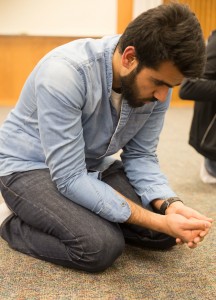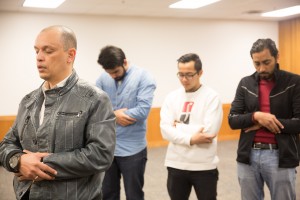The wavering of millennials in America’s religious landscape may not only be an issue, but also a question begging an answer. Where is everyone going? And what’s working to bring them back? To find answers, a team of Universe reporters spent a semester talking to religious experts around the country and to millennials themselves. What they found is presented in ongoing articles.
Fourth in a series. Part one deals with the rise of the ‘nones.’ Part two examines why millennials leave religion. Part three discusses the efforts religions make to appeal to millennials. Part five looks at millennials within the LDS community.

Timothy O’Malley is a millennial, but he is certainly not a “none.”
According to O’Malley, the 33-year-old director of liturgy at the University of Notre Dame, a Pew research study showing millennials are turning away from religion overlooks the large number of young adults who are still drawn to traditional religious institutions. He says that trying to reach millennials by merging religion and pop culture will ultimately fail.
“There’s a kind of secularizing move in this that, in the long-run, kills religious traditions. It doesn’t actually enable them to flourish,” O’Malley said. “And you can never get it back.”
While some experts lean toward marketing to millennials with coffeehouses and video games, O’Malley and others suggest holding firm to church tradition.
“I think there’s such an emphasis on marketing to young people that even religion is marketed to them,” said Colleen Carroll Campbell, author of “The New Faithful: Why Young Adults are Embracing Christian Orthodoxy.” She believes the approach is a turn-off. “And when they can find an authentic person who’s living their faith authentically and calling them to live with that same authenticity, that’s difficult; often that’s what begins to make the connection with them and excites them.”
Dean Inserra, the lead pastor at City Church in Tallahassee, is doing just that. Rather than coddling or catering to millennials, Inserra calls on them to follow the Jesus of scripture, rather than the Jesus of the times.
“From many pulpits, there is a Jesus preached who’s a good luck charm for you or who does fit modern culture’s agenda,” Inserra said. “People don’t want following Jesus to interfere with their life, and the reality is it always will.”
Inserra’s call to millennials to take up the cross resonates with them, he said, as evidenced by the 1,800 church members who regularly attend his Sunday meetings.
“We offer something bigger than individual spirituality. We offer a call to have the gospel in your life because Jesus is a Lord to follow, not to just admire,” Inserra said. “The preaching of a counter-culture is appealing to people instead of an agenda that is culturally conforming.”
O’Malley warns religious leaders to avoid placing a facade of outward “coolness” over their institutions. That doesn’t mean religious institutions and leaders shouldn’t be sensitive to prospective members’ beliefs and opinions on social issues. This requires some creativity and sensitivity when pitching “traditional church.”
“I think being honest and forthright is the right way to go,” O’Malley said. “I think using images and getting people in, doing something for the imagination, is the way to go.”
“There’s no reason to use gimmicky tricks; honesty is the best policy. Superficial advertising to attract members will only lead to a “disappointed congregation,” according to O’Malley.
“I know a number of traditions, to welcome in the next generation of young people into religion, they try to make religion cool, or hip. To me, that’s not actually what millennials want, because they can see through (pretense) quicker than most,” he said. “They can see through this.”
Just as O’Malley said millennials are more perceptive than some religious leaders might think, Campbell said many of them are just looking for something meaningful. Instead of molding church to fit millennials, Campbell said millennials appreciate being molded by church.
“There is a cohort, and I think a bigger one than a lot of ministry people realize, of young people who are just waiting for someone to challenge them and to say, ‘You know, actually it’s not all about you,’” Campbell said.
According to Campbell, young adults stay at church when the church asks something of them.
“The ones that attract them and keep them are the ones that make high demands of them,” Campbell said. “That’s in some ways surprising, but in other ways it’s human nature. … Young people are idealistic, and they want to be part of something bigger than themselves, and they want to believe in something that matters, beyond just their own petty concerns.”
According to Brent Top, dean of religious education at Brigham Young University, millennials stay involved in The Church of Jesus Christ of Latter-day Saints because the church focuses on inward conversion, which aligns with Campbell’s reference to the desire to believe in something that matters.
“Latter-day Saint millennials tend to be stronger because there is greater emphasis on the inward change and the conversion than the outward behavior of going to church or their outward beliefs,” Top said.
Teaching members at a young age to seek God and religiosity on their own keeps them involved with the church and brings true conversion, Top said. “What has the staying power is when you feel deep spiritual things in your own life and see how they make your own life better.”
Connecting the spiritual aspects to the religious practices is important to Hammad Javed, a Pakistani Muslim attending BYU. He listens to religious lectures and prays with a small group of fellow Muslims every Friday.

“The idea is you grow in religiosity and you grow in spirituality,” Javed said. “If you have both of them, then getting motivation isn’t hard. But if you just do religious stuff all the time, then you can’t be consistent because the spiritual aspect isn’t up to speed with how much religious stuff you’re doing.”
Illini Life, a Christian campus ministry at the University of Illinois, also gives millennials the chance to be part of something bigger.
“I think that Illini Life attracts millennial members by having a church model for students to encounter a real Christian community filled with people who have had their lives drastically changed by the work of Jesus Christ,” said Mark Holmes, a graduate student at the University of Minnesota who served on the Illini Life student board for four years.
Part of that model is the Home Fellowship program. Home Fellowships are Bible study groups Illini Life organizes with students, church leaders and Christian members of the community. Holmes said Home Fellowships “go beyond the scope of a typical Bible study due to the depth of our relationships.” He said his experience with these groups was the closest thing he had ever experienced to how the church is described in Acts 2 in the Bible.
O’Malley supported the idea that young adults like Holmes are willing to make an effort and that traditional church might not be so off-putting.
“To me, what’s necessary is an authentic return to the tradition in a way that’s true to the deepest reality of the tradition,” he said. “I know, for Catholics, one of the things that bring them back is the tradition of the church relative to prayer.”
It was the rich tradition of prayer that kept O’Malley close to Catholicism as a young boy in south Florida and Tennessee, and it’s a practice that continues to attract Catholic and Protestant youth from across the globe to the town of Burgundy, France.
O’Malley used France’s Taizé community, an ecumenical monastic order that started in Burgundy in 1940 by Brother Roger Schütz, as an example of a tradition drawing millennials. The community is comprised of more than 100 brothers from Catholic and Protestant traditions. Every year, more than 100,000 youths gather to worship in short prayer, biblical study and communal work.
“They sing very short musical tropes; often it is a day of silence. Interesting enough, this is where all of Europe desires to go in the summer, especially non-practicing Catholics,” O’Malley said. “One of the reasons I think they do is because it’s an encounter with the tradition and practices of the church that I think present a vision of human flourishing that a lot of young people are looking for. It’s actually being traditional, to show that the tradition has a way of life that is counter-cultural.”
According to O’Malley, the family may actually be the battleground for preserving and perpetuating religious traditions for future generations.

“Too often when I talk to the young adults I do at Notre Dame, they don’t have a sense of (tradition); they were never introduced to that and they don’t know it. The prevailing evidence that we’ve lost young adults is not that we lost the young adults, it’s that we lost their parents.”
The “nones” are, in effect, passing on their “noneness.”
O’Malley’s own personal experience bears this out. Raised in south Florida by what he considered “non-practicing” Catholic parents, he found himself knee-deep at an early age in the Catholic tradition at his local parish with the help of active grandparents. It was at this time he realized he had a disposition to religion and church tradition.
His grandparents gave him an avenue whereby he could explore religion by teaching him and making Catholicism accessible. In the same way, millennials need to learn the traditions, whatever the sect might be, in order to teach the subsequent generation. The prime focus then for all religious institutions, according to O’Malley, is to work with families.
“Once you have two consecutive generations gone that have no memory of what has happened, it’s exceedingly difficult to get it back,” O’Malley said. “Possible, but exceedingly difficult.”




